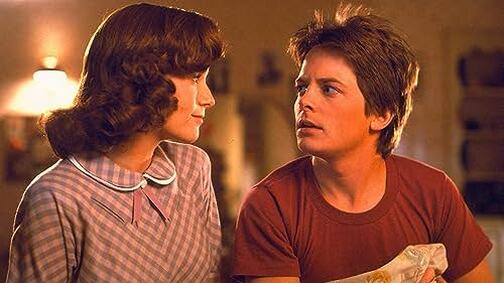A- | A scientist invents a time-traveling Delorean and his teen sidekick uses it to travel back in time to when his parents were his age. Directed by Robert Zemeckis Starring Michael J. Fox, Christopher Lloyd, and Lea Thompson Review by Jon Kissel |

I’m leaning too heavy into the incest and ignoring the time travel. Back to the Future presupposes that a teenager who pities his father George (Crispin Glover) would seek out paternal inspiration from local disgraced scientist Doc Brown (Christopher Lloyd). The relationship between Marty and Doc is taken for granted, but in a hilarious way that’s just as strange to consider as anything else happening here. Doc invents a time machine in the form of a DeLorean, and a mishap with a gang of Libyans with nuclear ambitions ends with Doc dead on the pavement and Marty sent back in time to 1955, when Doc first had the idea for time travel and Marty’s parents were his own age. Marty runs into his inept, bullied dad and unwittingly disrupts George’s meet-cute story with Lorraine, setting in motion a future where George never marries Lorraine and Marty ceases to exist. Concurrently, a younger Doc has to concoct a way to generate enough power to send Marty back to the future (it’s a good title), and thanks to a seemingly unimportant love note from Marty’s 1985 girlfriend written on the back of a historical society flyer, he knows the exact time and location of a lightning strike. While Marty plots to send a metaphorical bolt at his parents, Doc rigs up a system to catch a real one.
There’s nothing in the film that requires Lorraine to get the hots for Marty. The plot only needs her not to fall for George. Going with the squickiest route that a PG movie can get away with is heroic. America needed a reminder that the 50’s was not the wholesome paradise that the culture had been selling. Happy Days ended the year before Back to the Future’s release, to say nothing of the president from Hayes Code Hollywood whose appeal is predicated on turning back the clock to before the cultural revolutions of the 60’s. Zemeckis and Gale have clear and obvious thoughts about this kind of nostalgia. George and Lorraine’s meet-cute happens not by chance, but because he’s a peeping tom filling up his spank back from a tree limb with a bedroom window view. Lorraine’s strict values in 1985 bear no resemblance to the would-be sexpot of her youth. The town is cleaner, but the cops ask for bribes. Local bully Biff Tannen (Thomas F. Wilson) is one third-party act of cowardice away from being the local rapist.
Zemeckis’ resistance to nostalgia exists alongside his creating it. This and Indiana Jones were the regular franchises in my home growing up, and just as much as the snake-filled corpses in Raiders used to haunt my dreams, the thought of running a wire hook on top of my car to snare a power line is something that still pops into my head. Zemeckis is plugged into his audience’s dopamine transmitters, from the deep satisfaction of Biff and his cronies crashing into a manure truck to the series of thrumming wins that accompany the big clock tower sequence. The shot of Doc holding two ends of a power cable at opposite corners of the screen with a satisfied smile on his face, only for the ends to be too short, is a perfect visual joke that may as well have been crafted by Buster Keaton. Alan Silvestri’s score arriving at its climax as everything comes together, only to drop out as Marty vanishes and Doc dances in the streets is just as satisfying as it was when I watched this at 8 or 9. A review written back then would just be a series of Wow’s and substantially less uses of the word incest.
The grand sweep of the film is ultimately subservient to the details that make the repeat viewing experience so much richer. Thompson and Glover are the film’s true stars, because she’s acting like the horniest girl in the world and he’s a rubber-faced dork whose deep pathetic nature is so complete that his big win is just as much a surprise for the viewer as it is for him. Marty’s siblings aren’t important characters, but it’s such a specific choice to put his older 20-something brother in a Mickey Mouse t-shirt. Of all cars, going with a Delorean is idiosyncratic, less a shameless product placement than indicative of all the other ways this film is utterly itself. It laughs at how ridiculous its premise is, embodied by Doc doing deep eye rolls when seeing for himself how into Marty Lorraine is. A different movie would be framed as clueless if it deigned to put Lorraine’s attempted rapist Biff in her future home as a lickspittle manservant, but here, it’s one more can-you-believe-it oddity.
It's no surprise that Back to the Future holds up as a piece of entertainment, but it is surprising that it holds up this well. Is there some old age makeup not made for HD refinishing? Boy, is there. They didn’t figure out how to do necks until maybe the 2000’s. Does Marty need to return to the gym once George has punched out Biff and won Lorraine’s heart? No, he does not. George shouldn’t need to repeat his triumph with a goon who cuts in to dance. It’s the imperfections and singular choices that make Back to the Future so winning, the kind of film that modern studios attempt to remake whenever they put in culture references or needle drops to keep the adults entertained while their kids gawp at bright colors. Here, all parties can take in a meticulous crowd-pleaser while the parents get that little extra oomph from how bad that mom wants to fuck her kid. A
 RSS Feed
RSS Feed